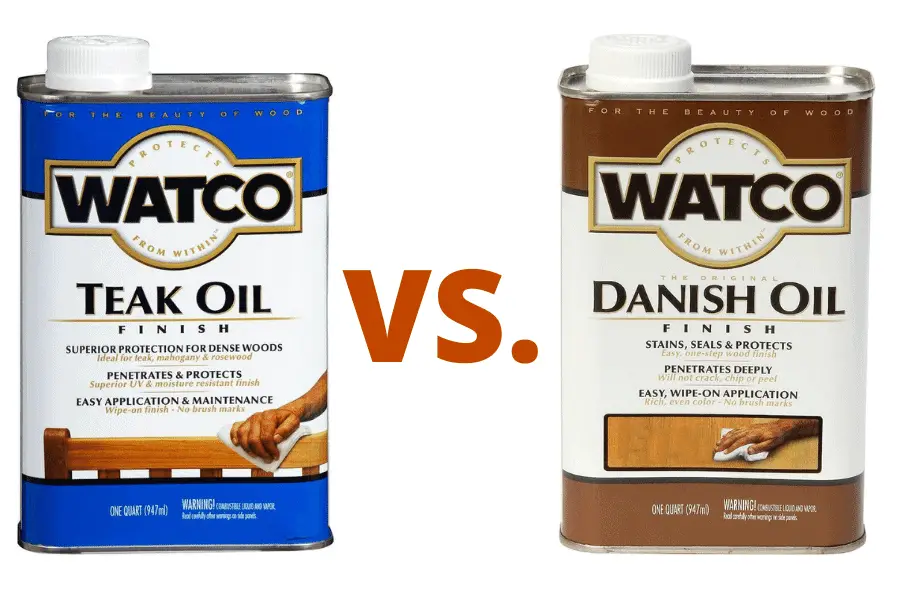
Teak Oil is a combination or blend of different solvents and oils, its used as varnish for items made of teakwood. It’s suitable for interior and exterior surfaces because it beautifies the wood grain, protecting it against UV rays and water stains.
Danish Oil is often made of polymerized linseed oil or tung oil, it is known as a hard-drying oil, woodworkers use it as a primer on bare wood before applying varnish or paint on it. It also provides a durable finish for wooden furniture, paneling, flooring, cabinetry, and others with superior protection from external damages, rotting, and other moisture damage forms.
Whether you’re dealing with furniture, timber flooring, or outdoor products, applying the right finish is critical to preserve the wood while bringing out its natural beauty.
There’s a lot of confusion among people regarding Danish Oil and Teak Oil in assuming these wood finishes are relatively similar?
Keep reading this article till the end because we are going to clear up the basics between these two types of wood oil and answer some commonly asked questions for better understanding.
First, it’s important to understand about wood oil before diving deep into this topic – Let’s get started!
What is Wood Oil?
Wood oil is a protective yet decorative coating, which applies directly over the top of wood stains or bare pieces. Moreover, the protective quality of wood oil is not as durable as varnishes. However, they’re still favorable among woodworkers because it brings the unique grains or wooden characters while adding an attractive gloss or sheen to the surface, which you can’t achieve in varnishes.
Here is our article on how to choose a wood finish for your project. https://topwoodworkingadvice.com/how-do-i-choose-a-wood-finish/
What are Different Type of Wood Oils?
The following are some of the classic wood oils used in woodworking:
- Linseed Oil
- Tung Oil
- Danish Oil
- Teak Oil
Here is our article on all the different types of wood finishes. https://topwoodworkingadvice.com/what-are-the-different-types-of-wood-finishes/
Now, let’s get into the real topic of distinguishing between Danish oil and teak oil!
What is Teak Oil?
Teak oil is the most popular oil among woodworkers that’s used on furniture, cabinets, and other products. It’s a combination or blend of different solvents and oil, allowing it to be used as a varnish for items made of teakwood.
It’s suitable for interior and exterior surfaces because it beautifies the wood grain, protecting it against UV rays and water stains.
How To Apply Teak Oil.
Subscribe to Rc Chaz on Youtube
What is Danish Oil?
Danish oil is a wood finishing oil, often made of polymerized linseed oil or tung oil that helps you achieve a lustrous wood finish.
It’s also known as hard-drying oil, which can polymerize into a compact form when it reacts with oxygen in the atmosphere. Normally, woodworkers used it as a primer on bare wood before applying varnish or paint on it.
How To Apply Danish Oil.
Subscribe to Fabian’s Tiny Workshop on Youtube
Is Danish Oil The Same As Teak Oil?
Absolutely Not! Both Danish oil and Teak oil are different from each other, penetrating deeply into the wood to protect from external damages and beautify its appeal.
The external appearance helps you distinguish between two oils because Danish oil is known for yielding and appearing a slightly glossier or lustrous finish. In contrast, the Teak oil is known for a long-lasting and slight sheen look.
Moreover, both oils are a solvent combination of linseed, tung oil, and other components, varying from brand to brand.
Can You Put Danish Oil Over Teak Oil?
Due to the same chemical composition with a slight difference in external appearance, you can use Danish oil over Teak oil to achieve a more glossy wood finish, but we don’t recommend to use because it works better as a base coat rather using as a top coat.
Actually, professionals preferred using Danish oil on sanded pieces. Still, if you would like to try it make sure the previous coat or excess oil has dried and removed before applying a Danish oil coat on it.
Does Danish Oil Darken Wood?
Yes! Danish oil will darken the wooden pieces slightly because it possesses penetrating characteristics, which can be mixed with oil-based solvents to create wood stains. If you’re using the Danish Oil composed by tung oil than it will not darken as much as composed by linseed oil.
When applied over wood, it cures to a firm satin finish that repels liquid well because the finish coating is not slippery or glossy. The product is ideal for items, such as food utensils or tool handles, giving some additional water resistance.
Can I Use Danish Oil On Pine?
Yes, due to its hard-drying characteristics, it becomes the most favorable wood oil for any softwood, such as pine. Because the oil provides the most durable finish for pine wood flooring, furniture, farming, paneling, and other wooden essentials.
The application is relatively easy; it not only adds a beautiful wet look but also protects it from moisture damages.
Is Danish Oil Poisonous?
Yes, the problem with today’s Danish Oil is not the “oil,” but the other toxic chemical components or solvents used to prepare such Oil. Numerous brands are competing to make a faster yet cheaper oil in which they cut back the natural oil quantity with increased other toxic ingredients.
So, if you’re planning to use a Danish Oil, then read the instructions carefully printed on the box and plan accordingly. You can also ask the manufacturer to review its MSDS sheet to understand toxic chemicals better. You must have taken precautionary measures, wearing a NIOSH respiratory mask, treating wood in an open atmosphere, and so on.
Worst case, you may face severe consequences like nausea, headaches, and vomiting. It’s best to check the manufacturer composition to evaluate the answer to this specific question regarding your Danish Oil.
